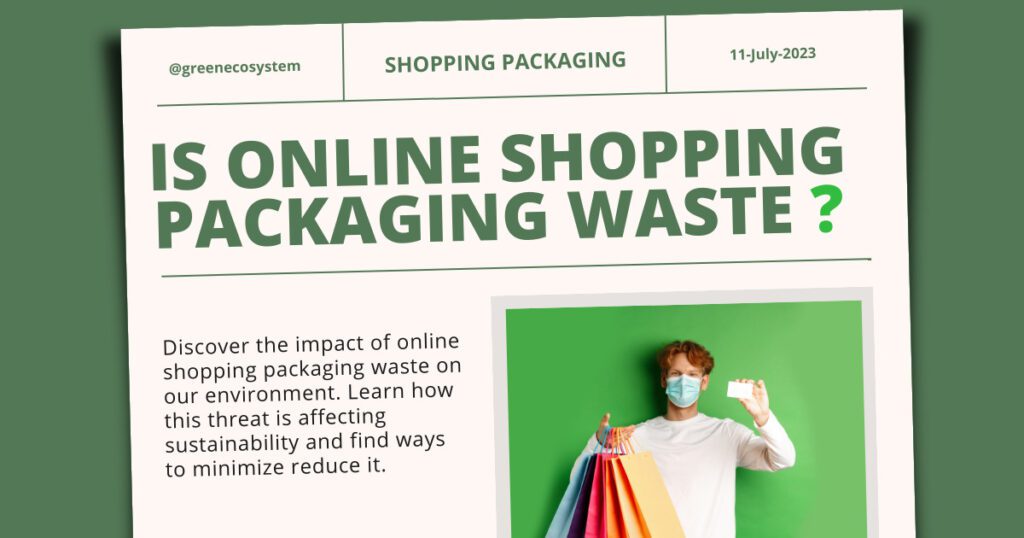
Introduction:
In today’s digital era, online shopping has taken the world by storm. With just a few clicks, consumers can order products from the comfort of their homes, saving time and effort. However, with the increase in online shopping, there has also been a surge in shopping packaging waste. In this blog, we will explore whether online shopping packaging waste poses a significant threat to the environment, particularly focusing on the impact of plastic waste in our green ecosystem.
The Rise of Online Shopping:
Over the past few years, online shopping has witnessed exponential growth. As more and more people choose to shop online, the demand for fast and efficient deliveries has also increased. Unfortunately, this convenience has come at a cost to our environment.
The Shopping Packaging Conundrum:
Online shopping has revolutionized the way we shop, but it has also brought along a new environmental challenge: packaging waste. With each purchase comes a flurry of cardboard boxes, plastic wraps, and Styrofoam peanuts. This excessive packaging not only clutters our homes but poses a significant threat to the environment. The production and disposal of these materials contribute to deforestation, pollution, and landfill overflow. As consumers, we must become more conscious of our choices and opt for sustainable packaging alternatives to minimize this conundrum and protect our planet.
Plastic Waste’s Impact on the Environment:
Plastic waste is a key concern in today’s world. It takes hundreds of years for plastic to decompose, contributing to pollution in landfills, oceans, and ecosystems worldwide. The environmental consequences of plastic waste include soil contamination, harm to marine life, and disruption of the delicate balance in our green ecosystem. Plastic pollution threatens not only aquatic life but also bird populations and other animals that mistake plastic for food.
The Rise of Online Shopping and Packaging Waste:
Online shopping has revolutionised the retail industry, offering convenience, variety, and doorstep delivery to consumers across the globe. However, one of the downsides of this trend is the excessive packaging waste generated by online retailers. The need for protection during transit often results in overpacking, unnecessary cardboard boxes, and copious amounts of plastic materials such as bubble wrap, air-filled cushions, and Styrofoam peanuts.
The Environmental Impact of Plastic Waste:
Plastic packaging waste poses a significant threat to the environment. Traditional plastics used in online shopping packaging, such as polyethylene and polypropylene, are not easily biodegradable and can persist in the environment for hundreds of years. Improper disposal of plastic waste leads to pollution of water bodies, soil degradation, and harm to wildlife. The sheer volume of plastic waste generated by the booming online shopping industry exacerbates these environmental concerns.
The Importance of a Greener Ecosystem:
To address the environmental impact of packaging waste from online shopping, it is crucial to establish a greener ecosystem that prioritises sustainable packaging practices. This can involve the adoption of eco-friendly alternatives to traditional plastic materials. For instance, bio-based plastics derived from renewable resources, such as corn starch or sugarcane, can be used as packaging materials. Additionally, promoting the use of recyclable and compostable materials is essential to minimize the carbon footprint associated with online shopping.
Sustainable Solutions:
Recognizing the environmental impact of online shopping packaging waste, measures are being taken to minimize its adverse effects. Here are a few notable solutions:
1. Eco-Friendly Packaging: Many businesses are switching to sustainable packaging materials such as recycled paper, biodegradable materials, and compostable plastics. These alternatives help reduce the amount of plastic waste generated by online shopping.
2. Optimal Packaging: Companies are encouraged to use minimum packaging necessary to protect the product, avoiding excessive layers and materials. This reduces waste and conserves resources.
3. Consumer Education: By educating consumers about the importance of recycling packaging materials and reducing waste, we can encourage eco-conscious behavior and increase awareness about the impact of plastic waste.
4. Reverse Logistics: Implementing efficient reverse logistics systems can help minimize packaging waste. Companies can design programs to collect and reuse packaging materials for future shipments, reducing the need for new packaging.
5. Right-Sized Packaging: Implementing packaging solutions that fit the size of the products, reducing the unnecessary use of materials.
6. Packaging Reduction: Encouraging minimalistic packaging practices without compromising the safety of the products.
7. Recycling Programs: Collaborating with recycling facilities and providing easy-to-follow instructions for consumers to responsibly dispose of packaging materials.
8. Biodegradable Alternatives: Identifying and promoting the use of environmentally friendly packaging materials such as recycled paper or plant-based plastics.
Conclusion:
While the convenience of online shopping cannot be denied, it is essential to address the environmental impact of excessive packaging waste, specifically plastic waste. Businesses and consumers must collaborate to find sustainable solutions by adopting eco-friendly packaging and promoting responsible consumption practices. By taking collective action, we can protect our green ecosystem and ensure a healthier future for generations to come.


